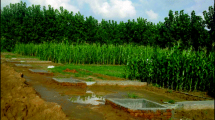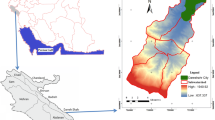Abstract
This study was the first to provide detailed methodological steps to estimate in-situ runoff curve number (CN) for selected agricultural fields in the State of Iowa via rainfall simulators. Representative fields in six counties were chosen to identify the effects of the following variables on runoff CN: rainfall intensity, soil type, soil moisture condition, tillage practice, and residue cover. The study also re-evaluated the range of the existing CN values for the different hydrologic soil groups in Iowa, and revised the equations describing the CN method to consider variables such as residue cover and soil moisture in a more detailed manner than the existing USDA method. The findings of this investigation showed that rainfall simulators are useful instruments for estimating in-situ runoff CN because rainfall intensity was adjustable during an experimental run. Further, the simulators eliminate the need of natural storm events. The range of the estimated CN values in summer agreed well (deviation less than 6%) with the reported CN values. However, the range of the estimated CN values in fall was generally less the reported CN values (deviation of about 40%) due to the high residue levels found in the fields after harvest. The effects of tillage practice and crop type were insignificant compared to residue cover and soil moisture. The study has also shown that the initial abstraction I a is not linearly proportional to the potential maximum retention S, which agrees with the available literature.
Similar content being viewed by others
References
Arnold JG, Williams JR, Nicks AD, Summons NB (1990) SWRRB—A basin scale simulation model for soil and water resources management. Texas A&M University Press, College Station
Auerswald K, Haider J (1996) Runoff curve numbers for small grain under German cropping conditions. J Environ Manag 47:223–228. doi:10.1006/jema.1996.0048
Bales J, Betson RP (1981) The curve number as a hydrologic index. In: Singh VP (ed) Rainfall runoff relationship. Water Resources, Littleton, pp 371–386
Beven K (1983) Surface water hydrology-runoff generation and basin structure. Rev Geophys 21(3):721–730. doi:10.1029/RG021i003p00721
Bhuyan SJ, Mankin KR, Koelliker JK (2003) Watershed-scale AMC selection for hydrologic modeling. Trans ASAE 46:237–244
Bondelid TR, McCuen RH, Jackson TJ (1982) Sensitivity of SCS models to curve number variation. Water Resour Bull 18:111–116
Brezonik PL, Bierman VJ, Alexander R, Anderson J, Barko J, Dortch M, Hatch L, Hitchcock GL, Keeney D, Mulla D, Smith V, Walker C, Whitledge T, Wiseman WJ (1999) Effects of reducing nutrient loads to surface waters within the Mississippi River Basin and the Gulf of Mexico: topic 4 report for the integrated assessment on hypoxia in the Gulf of Mexico. In: NOAA Coastal Ocean Program. Decision Analysis Series, no 18. National Oceanic and Atmospheric Admnistration Coastal Ocean Office, Silver Spring, pp 113
Draper N, Smith H (1998) Applied regression analysis, 3rd edn. Wiley, New York
Frasson RPM (2007) Observational studies of rainfall interception by corn. Master thesis, Department of Civil and Environmental Engineering, The University of Iowa
Graf WL (1988) Fluvial processes in dryland rivers. Springer, New York
Hawkins RH (1975) The importance of accurate curve numbers in the estimation of storm runoff. Water Resour Bull 11:887–891
Hawkins RH (1978) Runoff curve numbers with varying site moisture. J Irrig Drain Eng 104(4):389–398
Hawkins RH (1981) Interpretation of source-area variability in rainfall–runoff relationships. In: Singh VP (ed) Rainfall runoff relationship. Water Resources, Littleton, pp 303–324
Hawkins RH (1993) Asymptotic determination of runoff curve numbers from data. J Irrig Drain Eng 119(2):334–345. doi:10.1061/(ASCE)0733-9437(1993)119:2(334)
Hjelmfelt AT (1991) Investigation of curve number procedure. J Hydraul Eng 117(6):725–737. doi:10.1061/(ASCE)0733-9429(1991)117:6(725)
Hjelmfelt AT, Kramer LA, Burwell RE (1982) Curve numbers as random variables. In: Proceedings of the international symposium on rainfall–runoff modeling. Water Resources, Littleton, pp 365–373
Jain MK, Mishra SK, Babu PS, Venugopal K, Singh VP (2006) Enhanced runoff curve number model incorporating storm duration and a nonlinear Ia-S relation. J Hydrol Eng 11(6):631–635. doi:10.1061/(ASCE)1084-0699(2006)11:6(631)
Knisel WG (ed) (1980) CREAMS: a field-scale model for chemical, runoff and erosion from agricultural management systems. Conservation Research Report, No 26. USDA, Washington, DC
Linsley RK, Kohler MA, Paulhus JL (1986) Hydrology for engineers, 3rd edn. McGraw-Hill, New York
Littleboy M, Silburn DM, Freebairn DM, Woodruff D, Hammer UL, Leslie JK (1992) Impact of soil erosion on production in cropping land systems: 1. Development and validation of a simulation model. Aust J Soil Res 30:757–774. doi:10.1071/SR9920757
Marshall JS, Palmer WK (1948) The distribution of raindrops with size. J Meteorol 5:165–166
McCuen RH (2002) Approach to confidence interval estimation for curve numbers. J Hydrol Eng 7(1):43–48. doi:10.1061/(ASCE)1084-0699(2002)7:1(43)
McCuen RH (2003) Hydrologic analysis and design, 3rd edn. Prentice Hall, Englewood Cliffs
Mishra SK, Jain MK, Singh VP (2004) Evaluation of SCS-CN-based model incorporating antecedent moisture. Water Resour Manag 18(6):567–589. doi:10.1007/s11269-004-8765-1
Mishra SK, Jain MK, Bhunya PK, Singh VP (2005) Field applicability of the SCS-CN-based Mishra-Singh general model and its variant. Water Resour Manag 19(1):37–62. doi:10.1007/s11269-005-1076-3
Mishra SK, Sahu RK, Eldho TI, Jain MK (2006) An improved Ia-S relation incorporating antecedent moisture in SCS-CN methodology. Water Resour Manag 20:643–660. doi:10.1007/s11269-005-9000-4
Mishra SK, Singh VP (1999) Another look at SCS-CN method. J Hydrol Eng 4(3):257–264. doi: 10.1061/(ASCE)1084-0699(1999)4:3(257)
Mishra SK, Singh VP (2003) Soil conservation service curve number (SCS-CN) methodology. Kluwer Academic, Dordrecht
Nearing MA, Liu BY, Risse LM, Zhang XC (1996) Curve numbers and Green-Ampt effective hydraulic conductivities. Water Resour Bull 32(1):125–136
Norton LD (2006) A linear variable intensity rainfall simulator for erosion studies. In: Wanielista M, Smoot J (eds) Proc. of 2nd bieannial stormwater management research symp., May 4–5, 2006. Univ. of Central Florida, Orlando, pp 93–103
Papanicolaou AN, Abaci O (2008) Upland erosion modeling in a semi-humid environment via the water erosion prediction project model. J of Irrigation and Drainage Engineering, Ms. No. IRENG-07-5256R1, p 127
Papanicolaou AN, Elhakeem M, Krallis G, Prakash S, Edinger J (2008) Sediment transport modeling review—current and future developments. J Hydraul Eng 134(1):1–14. doi:10.1061/(ASCE)0733-9429(2008)134:1(1)
Ponce VM (1989) Engineering hydrology, principles and practices. Prentice Hall, Englewood Cliffs
Ponce VM, Hawkins RH (1996) Runoff curve number: Has it reached maturity? J Hydrol Eng 1(1):11–19. doi:10.1061/(ASCE)1084-0699(1996)1:1(11)
Rallison RE (1980) Origin and evolution of the SCS runoff equation. In: Proceedings of symposium on watershed management. ASCE, New York, pp 912–924
Rallison RE, Miller N (1981) Past, present, and future SCS runoff procedure. In: Singh VP (ed) Rainfall runoff relationship. Water Resources, Littleton, pp 353–364
Ravisangar V, Dennett KE, Sturm TW, Amirtharajah A (2001) Effect of sediment pH on resuspension of kaolinite sediments. J Environ Eng 127(6):531–538. doi:10.1061/(ASCE)0733-9372(2001)127:6(531)
Rawls WJ, Onstad CA (1978) Residue and tillage effects on SCS runoff curve number. In: American society of agricultural engineers for winter meeting. Chicago, 18–20 December 1978, p 18
Rawls WJ, Onstad CA, Richardson HH (1980) Residue and tillage effects on SCS runoff curve numbers. Trans Am Soc Agric Eng 23:357–361
Risse LM, Nearing MA, Savabi MR (1994) Determining the green-ampt effective hydraulic conductivity from rainfall–runoff data for the WEPP model. Trans Am Soc Agric Eng 37(2):411–418
Schneider LE, McCuen RH (2005) Statistical guidelines for curve number generation. J Irrig Drain Eng 131(3):282–290. doi:10.1061/(ASCE)0733-9437(2005)131:3(282)
Shahin M, van Orschot HL, Delange SJ (1993) Statistical analysis in water resources engineering. A. A. Balkema, Rotterdam
Sharpley AN, Williams JR (1990) EPIC—Erosion/productivity impact calculator: 1. model documentation. USDA-technical bulletin, No 1768. US Government Printing Office, Washington, DC
Silveira L, Charbonnier F, Genta JL (2000) The antecedent soil moisture condition of the curve number procedure. Hydrol Sci 45(1):3–12
SUDAS (2004) Statewide Urban design and specifications, Iowa statewide urban design standards manual. Chapter 3: stormwater management and drainage, Central Iowa Metropolitan Areas and Municipalities
USDA (1986) Urban hydrology for small watersheds. Technical release, no 55 (TR-55). Soil Conservation Service, Washington, DC
USDA (1993) Soil survey manual. Handbook 18. Soil Conservation Service, Washington, DC
Wehmeyer LL (2006) Evaluation of design flood frequency methods for Iowa stream. M.Sc. Thesis, Department of Civil and Environmental Engineering, The University of Iowa, Iowa, USA
Williams JR, Nicks AD, Arnold JG (1985) Simulator for water resources in rural basins. J Hydraul Eng 111:970–986
Young RA, Onstad CA, Bosch DD, Anderson WP (1987) AGNPS, agricultural non-point source pollution model—a watershed analysis tool. USDA Conserv Res Rep 35:1–80
Young RA, Onstad CA, Bosch DD, Anderson WP (1989) AGNPS: a non-point source pollution model for evaluating agricultural watersheds. J Soil Water Conserv 44(2):168–173
Young RA, Onstad CA, Bosch DD, Anderson WP (1994) Agricultural non-point source pollution model. Version 4.03, AGNPS User’s Guide. North Central Soil Conservation Research Laboratory, Morris, Minnesota
Yu B (1998) Theoretical justification of SCS method for runoff estimation. J Irrig Drain Eng 124(6):306–310. doi:10.1061/(ASCE)0733-9437(1998)124:6(306)
Author information
Authors and Affiliations
Corresponding author
Rights and permissions
About this article
Cite this article
Elhakeem, M., Papanicolaou, A.N. Estimation of the Runoff Curve Number via Direct Rainfall Simulator Measurements in the State of Iowa, USA. Water Resour Manage 23, 2455–2473 (2009). https://doi.org/10.1007/s11269-008-9390-1
Received:
Accepted:
Published:
Issue Date:
DOI: https://doi.org/10.1007/s11269-008-9390-1




